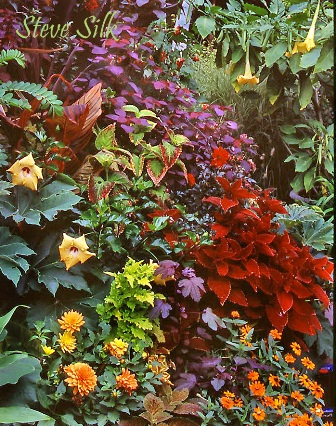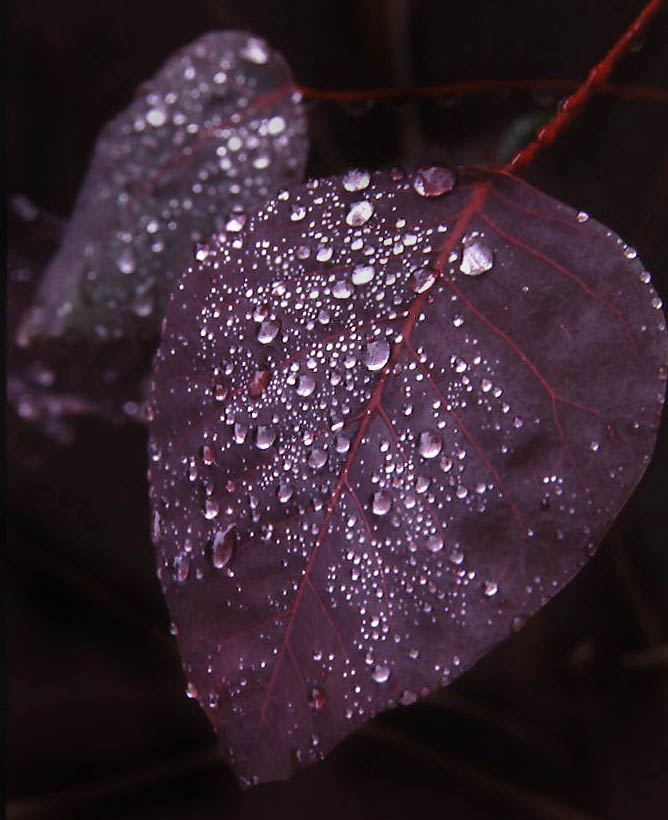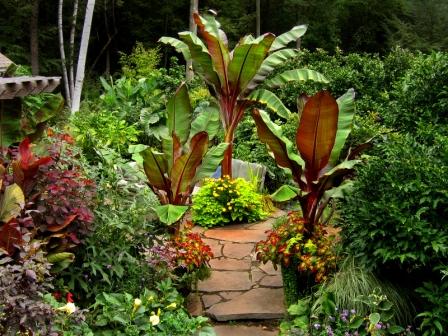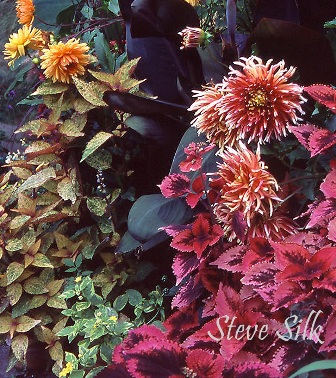I’ve got a thing for dark foliage. I love its smoky, sultry color, the way it can deepen a planting and lend it an air of mystery at the same time. It’s also a great foliage contrast with almost any other color and since I’m one of those who believes in building gardens from the leaves out, it’s an essential building block in almost any planting scheme I concoct. It’s a great companion for anything chartreuse, a pairing I use in profusion. And last but not least, those moody hues are a superlative background for any bright, hot color–yellow, orange or red.
I also like annuals, tender perennials and tropicals and am ever on the hunt for new ones, especially those with foliage that’s ABG—anything but green. A few of my favorites provide an excess–no wait, that’s not possible–of that deep dark foliage I find so alluring. Some are small statured and provide hints of that color in subtle ways, while others loom larger and deliver a giant jolt of drama. Here are few of my big ones, the heavy hitters:
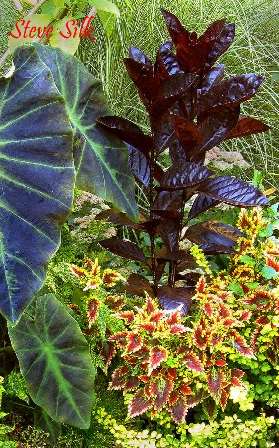 It doesn’t get any darker than the inky black abyss created by Pseuderanthemum atropurpureum. I think of it as the horticultural equivalent of a cosmic black hole; it’s Darth Vader dark. Mine have grown to 2 or 3 feet tall in the course of a season, so although they are not the biggest kid on the block, their glossy midnight leaves steal the show wherever I place them. I’ve had fun growing them in a pot and plunking it down here and there just to gauge the effect. It’s always striking. I never get tired of looking at this plant, especially if it’s surrounded by a see-through scrim of frilly yellows or oranges, say some fern-leafed marigolds (Tagetes tenuifolia).
It doesn’t get any darker than the inky black abyss created by Pseuderanthemum atropurpureum. I think of it as the horticultural equivalent of a cosmic black hole; it’s Darth Vader dark. Mine have grown to 2 or 3 feet tall in the course of a season, so although they are not the biggest kid on the block, their glossy midnight leaves steal the show wherever I place them. I’ve had fun growing them in a pot and plunking it down here and there just to gauge the effect. It’s always striking. I never get tired of looking at this plant, especially if it’s surrounded by a see-through scrim of frilly yellows or oranges, say some fern-leafed marigolds (Tagetes tenuifolia).
Another sure fire winner is this tropical smokebush (Euphorbia cotinifolia). I can’t understand why I don’t see this plant just everywhere. It looks a lot like purple smokebush—hence the common and botanic names—but there’s more of a molten red in its leaf color. It is utterly stunning when early morning or late afternoon sun shines through those leaves. You cannot go wrong blending this with any other hot color, or as in this shot, as an anchor for a whole slew of hot colors. It’s almost foolproof. And look how droplets of rainwater bead up on the leaves like little jewels. This is an easy plant to overwinter-I just stick it in the dark cold basement and in a few years I have plants 6 feet tall.
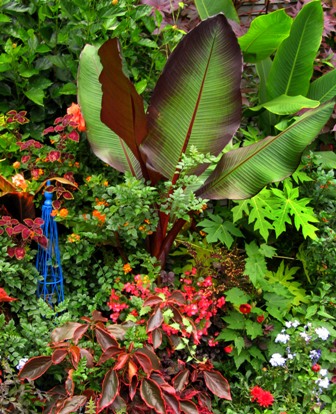 As you might have guessed I dwell in a state of deep zonal denial, as evidenced by, among other things, my collection of banana plants, none of which outshine this banana relative, the splendiferous red Abyssinian banana (Ensete ventricosum ‘Maurelii’). Not only are its leaves brushed with beauteous burgundy, they are tough, tough, tough – so leathery they don’t get shredded by wind and rain like the leaves of so many other bananas. And the trunk…I prune off old leaves at the base to expose the almost ebony gloss of this faux banana’s trunk. This is another easy-to-overwinter plant: dark and dormant in the cold basement. Plants three years old easily reach 8 feet or more and bear leaves big enough to hide behind. The biggest one in the photo of the trio is only in its 3rd year.
As you might have guessed I dwell in a state of deep zonal denial, as evidenced by, among other things, my collection of banana plants, none of which outshine this banana relative, the splendiferous red Abyssinian banana (Ensete ventricosum ‘Maurelii’). Not only are its leaves brushed with beauteous burgundy, they are tough, tough, tough – so leathery they don’t get shredded by wind and rain like the leaves of so many other bananas. And the trunk…I prune off old leaves at the base to expose the almost ebony gloss of this faux banana’s trunk. This is another easy-to-overwinter plant: dark and dormant in the cold basement. Plants three years old easily reach 8 feet or more and bear leaves big enough to hide behind. The biggest one in the photo of the trio is only in its 3rd year.
Cannas also deliver a large-leaved jolt to any garden setting, and there are a few splendid dark-leaved cultivars that really pay the rent. I like 5-foot-tall ‘Australia’ with its rather slender, blade-shaped leaves, and 3-foot ‘Dark Knight’, with broader, paddlelike leaves. As for the flowers, I generally don’t care much for them and usually lop them off – too strident in mannered company. Instead, I grow these for their foliage. And I’ve noticed that ‘Dark Knight’ in particular is a good plant to use when transitioning from one color to another. I think of it as a pivot point. For example, I’d never put these reddish coleus and dahlias next to the yellowish ones, but with the big black leaves in between serving as a kind of moderator, the transition eases. I think it works fine.

